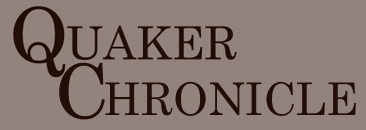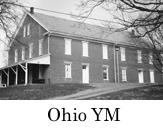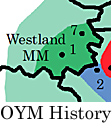Elisha Bates (1781-1861) was a leading Ohio Quaker minister and printer of the early 19th century who was involved with the initial stages of the Beaconite controversy. Bates lived just west of Mount Pleasant, Ohio, during the most influential years of his life.
Bates was born in eastern Virginia in 1781. His family was prominent in Skimmino Preparative Meeting. When he moved to Short Creek MM, Ohio Yearly Meeting in 1817, Bates brought along the Skimmino PM minute book, and it is currently located at Malone College.
Printer
In 1818, Bates purchased a magazine printed by Charles Osborn in Mount Pleasant and began a publication of his own. Bates's publication went through several different names, the most important of which was the Miscellaneous Repository. Bates had two compositors, one of whom was consistently drunk and gave the other one (who later published his memoirs) half of his money for doing all of the work. Bates was away on religious visits a lot and did not know about the problem. In addition to the Miscellaneous Repository, Bates was often hired to print a broadside containing extracts from the men's yearly meeting minutes.
Elisha Bates's printing shop was located near the Ohio Yearly Meeting House at Mount Pleasant. His shop was demolished many decades ago, and later a house was built on the site. In the 1990s, the owners reported finding pieces of type in the yard while doing work on occasion.
Minister
In 1819, Short Creek MM recommended Elisha Bates be recognized as a minister [minutes, 1/19/1819]. He then served as Clerk of Ohio Yearly Meeting in 1819. That year, changes to the Discipline had been completed, and the first edition was printed by Elisha Bates. Bates had a difficult time as Clerk. He was troubled by some poorly chosen words offered by a visiting minister, and Bates' insistence on not endorsing the travelling minister's minute upset Horton Howard, who was serving that year as Assistant Clerk of the men's Ohio YM. Then on Bates's way home, he lost the committee reports that were supposed to be entered into the minute book.
Bates undertook several travels in the 1820s and early 1830s. His first travel with a minute took place in 1823, when he visited with each family of Short Creek MM [minutes, 6/24/1823 and 9/23/1823]. Later in 1823, he and minister Jonathan Taylor visited Indiana Yearly Meeting [Short Creek MM 9/23/1823]. During these travels, Bates would visit with Friends in their homes. When possible, he would meet with people formerly associated with Quakers and attempt to have them reinstated.
Bates's wife Sarah J. Bates was recognized as an Elder in 1824 [SCMM 8/24/1824].
Also in 1824, Bates's most famous book was printed. Entitled Doctrines of Friends (and posted here), the book was one of the most important Quaker doctrinal treatises of the years 1775-1825. Portions of the book were reprinted later, and some of it was copied by hand into the journals of young Friends who later became prominent. The book was criticized by some Friends at the time for not emphasizing the inward manifestation of Christ Jesus.
The Hicksite Division
Bates became prominent among those Friends who opposed the ministry of Elias Hicks, and some of Bates's sermons against Hicks were printed by Marcus T.C. Gould in the 1820s. Bates played a major role in the decision of Ohio Yearly Meeting in 1827 to recognize the Orthodox Philadelphia Yearly Meeting.
In 1828, Ohio Yearly Meeting (Orthodox) called on all Orthodox yearly meetings to send representatives to the first session of the General Committee, to be held in 1829. The GC was held at Mount Pleasant, and Elisha Bates served as Clerk of the event. At this meeting, a document was approved for printing named The Testimony of the Society of Friends on the Continent of America. The text of the book is posted here. It was later speculated in the periodical The Journal of the Friends Historical Society that Bates drafted large portions of the work. When published originally in 1830, the pamphlet included the minutes of approval adopted by each Orthodox yearly meeting - including the minute signed by Elisha Bates on behalf of Ohio Yearly Meeting and a minute signed by his brother Fleming Bates, who was Clerk of Virginia Yearly Meeting.
The Testimony was sent to all Orthodox yearly meetings to be approved in 1829 before it was printed for distribution. When Ohio YM met that year, Bates was appointed to serve as the men's clerk; he served 1829-1831. He was thus the only person to serve three nonconsecutive terms as Clerk of Ohio Yearly Meeting.
Disownment and Later Life
In the early 1830s, Bates's ministry began to suffer. Friends noted that he was misquoting and misapplying scripture, and several Elders worked with him to try to nurture his ministry. Bates countered that they did not appreciate scripture. Soon thereafter, Bates began to adopt Anglican religious terminology and denying the existence of spiritual rebirth. Bates travelled to England (without asking for a travelling minute), where he met with Isaac Crewdson, Joseph John Gurney, and some Friends who were associated with Crewdson's Beaconite supporters. While in England, Bates chose to have himself "baptized" with water. Ohio Friends were unnerved by Bates' unexplained behavior, and he was disowned in 1837. That same year, he printed a book defending himself, but the book undermined his assertion that he was not irrational. The book set forth his opinions on his treatment in addition to a quite negative critique of George Fox and some early Quakers. He appealled his disownment to Short Creek Quarterly Meeting, which sustained the decision. During a heated discussion of Bates's case on the yearly meeting floor, Philadelphia minister Thomas Kite warned Ohio Friends they should worship the Creator and not the creature, and this warning played a key role in the YM deciding to sustain Bates's disownment.
One reason behind Gurney's travels to the USA in 1837 was to help support Bates, but he did not arrive at Mount Pleasant in time to do that.
Bates left Quakerism. He became a Methodist and served as a minister among them for a time, but later his membership in that organization was also revoked.
Near the end of his life, Bates became interested in Quakerism again. He is reported to have sat on the rear benches during worship in the old brick Short Creek Meeting House west of Mount Pleasant, though he never returned to membership. He died on Eighth Month 5th, 1861, and his remains were interred in the Short Creek burial ground.
Sources: EAQG 4:174; 6:155 |






